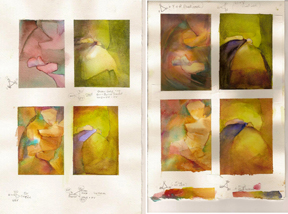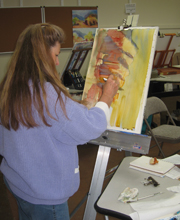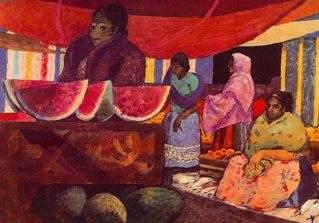Let’s start with the WOW! factor. On occasion, there are paintings, there is music, there are other forms of art that leave you speechless. They are that good. There are paintings that have moved me to tears, as there is music. You know what I mean.
 This is a non-verbal communication. I took an entire semester on the Aesthetics of Art — reading countless approaches. But after all the words, what they wee really saying was — word don’t SAY it. You know. Wow!
This is a non-verbal communication. I took an entire semester on the Aesthetics of Art — reading countless approaches. But after all the words, what they wee really saying was — word don’t SAY it. You know. Wow!
Kathryn Brooksforce studies with color 02 08
 But what if, instead, you are mystified. Is the problem with you or with the artist? It could be either. Are you coming with preconceived ideas of what makes art or are you letting the piece explain itself.
But what if, instead, you are mystified. Is the problem with you or with the artist? It could be either. Are you coming with preconceived ideas of what makes art or are you letting the piece explain itself.
Let your eyes do the walking.
I used to teach a seminar on looking at unfamiliar paintings. It would meet at an annual juried show which always included quite a few challenging pieces.
Susan Hernday Madronas, 09 09
Rules:
- 1. Ask yourself what you think the artist is trying to say with the means he or she chose to use.
- 2. How did he/she use color, value, and shape. Why were these particular shapes-values-colors chosen? Take your time on this one.
- 3. Was he/she effective in these choices?
- 4. If not, why not?
- 5. What else did he/she use? — Line, texture, movement, etc? Was that effective?
- 6. How important is content or story line?
- 7. Do you think he/she achieved the results you think was the goal?
Only now may you say whether you like it or not. No subjective statements of approval or disapproval before this.
 Jeanie Young’s Tulips 05 09
Jeanie Young’s Tulips 05 09
Why can you not insert YOU until you answered the first series of questions? What if the artist was trying to express anger or sadness and you don’t feel like experiencing those moods? Then the more effective the piece, the more you won’t “like” it.
Jeanie Young’s Tulips 05 09
I don’t read violent books and I don’t like to watch violence in the movies. It upsets me. I don’t sleep well. I don’t want to go there. For example, I found No Country for Old Men senselessly violent. But look how many Oscars it won. For me, The Brave One (Jodie Foster, NYC Central Park incident) was much the better film. I found the development of the character much more interesting. The violence was well handled. So says I…. (the Academy didn’t agree)
In the same way, we aren’t all going to agree about the good, better, best paintings. When you are at a juried show, see if you can identify, by the paintings selected, the important elements to the juror. Is space important? Is technique? Are were paintings accepted that you think you have seen over and over?
Betty Burton at work 04 09
 As artists, notice what excites you. I call it “creative envy.” Some paintings are so good, you wish you had done them. Ask yourself what it was this artist was doing. Make that part of how you work on your next painting. See if considering this approach doesn’t make you stretch..
As artists, notice what excites you. I call it “creative envy.” Some paintings are so good, you wish you had done them. Ask yourself what it was this artist was doing. Make that part of how you work on your next painting. See if considering this approach doesn’t make you stretch..
Having Millard Sheets the first national juror the Watercolor Society of Oregon had. was my first act as president of the Society in 1980. He helped get it off to a great start. At the award ceremony he said, “Learn the techniques so that your lack of knowledge doesn’t get in your way. Learn the art of the ages. That is how you develop your sense of aesthetics. Paint your passion.” What fantastic advice!
Millard Sheet’s Watermelon Lady
 By passion he means what you really care about. You don’t have to be able to say it — just feel it. Sure it can be about kittens, or the light on old wood. An artist’s passion can be about the way color moves, the way shapes lead you across the surface of the paper. for example, look at the variety of ways Millard Sheets uses reds in Watermelon Lady. Look at how the shapes are arranged.
By passion he means what you really care about. You don’t have to be able to say it — just feel it. Sure it can be about kittens, or the light on old wood. An artist’s passion can be about the way color moves, the way shapes lead you across the surface of the paper. for example, look at the variety of ways Millard Sheets uses reds in Watermelon Lady. Look at how the shapes are arranged.
Sally Mitchell’s Villa 04 09
 Let me suggest that if you have a group of artist friends, you go to a gallery or a museum and try the questions that started this “technique.” Each one choose a different painting and talk about it — working through the list of questions without any subjective judgments. Have the others guess if you like it or not.
Let me suggest that if you have a group of artist friends, you go to a gallery or a museum and try the questions that started this “technique.” Each one choose a different painting and talk about it — working through the list of questions without any subjective judgments. Have the others guess if you like it or not.
And a last suggestion: If there is a personal “Oh Wow!” in the gallery, buy it! Make a place for it in your home and let it tell you about its magic. I have always regretted that I didn’t buy my “best of show” at the American Watercolor Society Show during the years we lived near New York. Unknowns have since become famous. But think of the magic of living with those pieces all these years. Wow!
Caroline Buchanan
©2009
